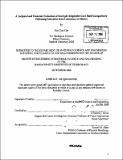| dc.contributor.advisor | Darrell J. Irvine. | en_US |
| dc.contributor.author | Cho, Eun Chol, M. Eng. Massachusetts Institute of Technology | en_US |
| dc.contributor.other | Massachusetts Institute of Technology. Dept. of Materials Science and Engineering. | en_US |
| dc.date.accessioned | 2009-04-29T17:30:31Z | |
| dc.date.available | 2009-04-29T17:30:31Z | |
| dc.date.copyright | 2008 | en_US |
| dc.date.issued | 2008 | en_US |
| dc.identifier.uri | http://hdl.handle.net/1721.1/45360 | |
| dc.description | Thesis (M. Eng.)--Massachusetts Institute of Technology, Dept. of Materials Science and Engineering, 2008. | en_US |
| dc.description | Vita. | en_US |
| dc.description | Includes bibliographical references (leaves 64-69). | en_US |
| dc.description.abstract | Many potentially powerful therapeutic strategies for the treatment of disease require the delivery of drugs into the cytosolic or nuclear compartments of cells. Members of the Irvine laboratory have developed a novel pH-responsive core-shell nanoparticle system that can achieve efficient and non-cytotoxic drug delivery into the cytosol. Another advantage is that the shell can be easily modified to bind to different types of drug agents and incorporate ligands for specific cell targeting. Experimental analysis of the newly synthesized nanoparticles with various shell structures has demonstrated that modification of the shell does not compromise their cytosolic delivery. These nanoparticles, if successful, will improve the therapeutic potential of a wide range of drugs. However, critical issues on the research side need to be resolved, and an appropriate intellectual property strategy should be initiated in the near future. Applications to siRNA delivery and vaccines have been examined in depth, as cytosolic delivery is one of the main challenges in these fields. Partnerships with large pharmaceutical companies are critical in order to acquire key patents on siRNA/antigen. Even though the market is competitive, there is a strong demand for innovative delivery platforms; provided that the overall profile of the core-shell nanoparticles is comparable to that of emerging drug delivery systems, and a strong intellectual property portfolio is developed, the Irvine technology should be able to compete in the market. After analyzing risks on the business side, including the FDA approval process, a suggested business strategy is outlined, through which value can be successfully obtained throughout the existing pharmaceutical supply chain from the novel drug delivery system. | en_US |
| dc.description.abstract | (cont.) The Irvine technology company will develop formulations, contract manufacturers will produce the nanoparticles, and pharmaceutical companies will concentrate on clinical trials, late-stage development and sales and marketing. A case study on the liver cancer market has demonstrated that commercial development of the Irvine nanoparticles can be a financially successful endeavor. | en_US |
| dc.description.statementofresponsibility | by Eun Chol Cho. | en_US |
| dc.format.extent | 71 leaves | en_US |
| dc.language.iso | eng | en_US |
| dc.publisher | Massachusetts Institute of Technology | en_US |
| dc.rights | M.I.T. theses are protected by
copyright. They may be viewed from this source for any purpose, but
reproduction or distribution in any format is prohibited without written
permission. See provided URL for inquiries about permission. | en_US |
| dc.rights.uri | http://dspace.mit.edu/handle/1721.1/7582 | en_US |
| dc.subject | Materials Science and Engineering. | en_US |
| dc.title | A technical and economic evaluation of novel pH-responsive core-shell nanoparticles : delivering innovation from laboratory to market | en_US |
| dc.type | Thesis | en_US |
| dc.description.degree | M.Eng. | en_US |
| dc.contributor.department | Massachusetts Institute of Technology. Department of Materials Science and Engineering | |
| dc.identifier.oclc | 316803193 | en_US |
